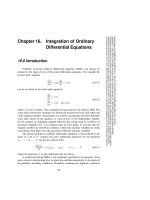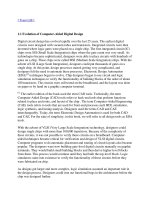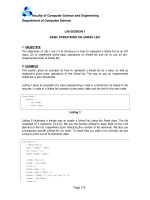Faculty of Computer Science and Engineering Department of Computer Science Part 1 doc
Bạn đang xem bản rút gọn của tài liệu. Xem và tải ngay bản đầy đủ của tài liệu tại đây (171.23 KB, 5 trang )
Faculty of Computer Science and Engineering
Department of Computer Science
Released on 03/09/2012 10:09:56 1/5
DATA STRUCTURES & ALGORITHMS
Tutorial 1 Questions
COMPUTATIONAL COMPLEXITY
Required Questions
Question 1.
Reorder the following efficiencies from the smallest to the largest:
a. 2n
3
+ n
5
b. 2000
c. 4
n+1
d. n
4
e. (n-1)!
f. nlog
2
(n)
g. 2klog
k
(n) (k is a predefined constant)
Solution:
Efficiency: a measure of amount of time for an algorithm to execute (Time Efficiency) or a
measure of amount of memory needed for an algorithm to execute (Space Efficiency).
Non-decreasing order: 2000 < 2k log
k
(n) < n log
2
(n) < n
4
< 2n
3
+n
5
< 4
n+1
< (n-1)!
Question 2.
Determine the big-O notation for the following:
a. 2n
6
b. 100n + 10.5n
2/3
+ 5.2n
5/7
c. 9log
2
(n)
d. 5n
10
+ 2logn
e. n! + k! (k is a predefined constant)
f. 100log
2
(n) + 5(n+2n)
Solution:
a. O(n
6
) b. O(n) c. O(log
2
(n)) d. O(n
10
) e. O(n!) f. O(n)
Question 3.
Calculate the run-time efficiency of the following program segment:
1 i = n-1
2 loop (i >= n/2)
1 j = 1
2 loop (j < n/2)
1 print(i, j)
2 j = j + 2
3 end loop
4 i = i - 2
3 end loop
Solution: (Note: [n/2] = n/2 rounded down)
If [n/2] is odd, the run-time efficiency is: n/4.n/4 = n
2
/2 => O(n
2
)
Faculty of Computer Science and Engineering
Department of Computer Science
Released on 03/09/2012 10:09:56 2/5
If [n/2] is even, the run-time efficiency is: n/4.(n/4-1) => O(n
2
)
Or generally, the run-time efficiency of the given program segment is O(n
2
).
Question 4.
Calculate the run-time efficiency of the following program segment:
1 i = n
3
2 loop (i >= n/2)
1 j = 1
2 loop (j < n/2)
1 print(i, j)
2 j = j + 2
3 end loop
4 i = i / 2
3 end loop
Solution:
There are 2 nested loops, the iteration of variable i is executed 2log
2
n(n
3
/2
x
=n/2 => x = log
2
n
2
=
2log
2
n) times, j is executed n/4( or (n/4)-1) times,
Therefore, the run-time efficiency is 2(log
2
n)* n/4= O(nlog
2
(n)).
Question 5.
If the algorithm doIt has an efficiency factor of 2n, calculate the run time efficiency of
the following program segment:
1 i = 1
2 loop (i <= n)
1 j = 1
2 loop (j < n)
1 k = 1
2 loop (k <= n)
1 doIt(…)
2 k = k *2
3 end loop
4 j = j + 1
3 end loop
4 i = i + 1
3 end loop
Solution:
There are 3 nested loops, the iteration of variable i is executed n times, j is executed n-1 times, k is
executed log
2
(n)+1 times.
Therefore, the run-time efficiency is n(n-1)(log
2
(n)+1)(2n) = O(n
3
log
2
(n)).
Question 6.
Given that the efficiency of an algorithm is 2
n
log
2
(n
4
), if a step in this algorithm takes 1
nanosecond (10
−9
), how long does it take the algorithm to process an input of size 1024?
Solution:
It takes: 2
1024
log
2
(1024)×10
-9
≈ 10
360
s
Question 7.
Faculty of Computer Science and Engineering
Department of Computer Science
Released on 03/09/2012 10:09:56 3/5
Write a recurrence equation for the running time T(n) of g(n), and solve that recurrence.
Algorithm g (val n <integer>)
Pre n must be greater than 0
Return integer value of g corresponding to n
1 if (n = 1)
1 return 1
2 else
1 return g(n – 1)+ 1
End g
Solution:
T(1) = 1; T(n) = 1 + T(n-1) = 1 + 1 + T(n-2) = 1 + 1 + … + 1 + 1 + T(1) = n = O(n)
Faculty of Computer Science and Engineering
Department of Computer Science
Released on 03/09/2012 10:09:56 4/5
Advanced Questions
Question 8.
Prove that for any positive functions f and g, f(n) + g(n) and max(f(n), g(n)) are asymptotically
equivalent (i.e. they yield the same big-O notations).
Solution: max(f(n), g(n)) ≤ f(n) + g(n) ≤ 2max(f(n), g(n)).
Question 9.
Estimating the time complexity of the following program segment:
1 i = 0
2 loop (i < N)
1 j = i
2 loop (j < N)
1 k = 0
2 loop (k < M)
1 x = 0
2 loop (x < K)
1 print(i, j, k)
2 x = x + 3
3 end loop
4 k = k + 1
3 end loop
4 k = 0
5 loop (k < 2*K)
1 print(k)
2 k = k + 1
6 end loop
7 j = j + 1
3 end loop
4 i = i + 1
3 end loop
Solution:
K%3 is 2 or 1:
N*(M*(K/3)+2*K) + (N-1)*(M*(K/3)+2*K)+ + 1*(M*K/3+2*K=N*(N+1)*(M*K/3+2*K)/2=
O(N
2
*M*K)
K%3 is 0:
N*(M*[(K/3)-1]+2*K) + (N-1)*(M*[(K/3)-1]+2*K)+ + 1*(M*[(K/3)-
1]+2*K=N*(N+1)*(M*[(K/3)-1]+2*K)/2= O(N
2
*M*K)
Question 10.
Calculate the run-time efficiency of the following program segment:
1 i = n
2 k = n/3
2 loop (i >= k)
1 j = n – 2*k
Faculty of Computer Science and Engineering
Department of Computer Science
Released on 03/09/2012 10:09:56 5/5
2 loop (j < i)
1 print(i, j)
2 j = j + 2
3 end loop
4 i = i - 1
3 end loop
Solution:There are 2 nested loops, the iteration of variable i is executed (2/3)*n () times, j is
executed n/3 times,
Therefore, the run-time efficiency is (2/3)*n*(n/3)= O(n
2
).
Question 11.
Write a recurrence equation for the running time T(n) of f(n), and solve that recurrence.
Algorithm f (val n <integer>)
Pre n must be greater than 0
Return integer value of f corresponding to n
1 if (n <= 1)
1 return 1
2 else
1 return f(n – 1) + f(n – 2)
End
Solution:
f(0) = f(1) = 1.
Upper bound:
f(n)=f(n-1)+ f(n-2)+1 ≤ 1+ f(n-1) + f(n-1) = 1+ 2*f(n-1)=1+ 2*[1+f(n-2)+f(n-3)]≤ 1+ 2*[1+f(n-
2)+f(n-2)]= 1+2 +4*f(n-2) ≤ ≤ 1 +2 +2
2
+ … +2
n-1
=2
n
-1=O(2
n
).
Lower bound:
f(n)=f(n-1)+ f(n-2)+1= f(n-2) + f(n-3) + f(n-2)≥ 1+f(n-2)+ f(n-2)= 1+ 2*f(n-2)=1+ 2*[f(n-3)+f(n-
4)] ≥ 1+ 2*[1+f(n-4)+f(n-4)]=1+2 +4*f(n-4)≥ ≥1+2+2
2
… +2
n/2-1
= 2
n/2-1
-1=Ω(2^(n/2)
Question 12.
Solve recurrence f(n) = 2f(√n) + log
2
n. (Hint : change variables, with m = 2
n
)
Solution: Let m=log
2
n => g(m)=f(2
m
). Then
f(n)=2f(n
1/2
) + log
2
n
f(2
m
)=2f(2
m/2
) +m
g(m)=2g(m/2)+m
We are easy to determine g(m)=2g(m/2)+m=O(m*log(m)). To change back to
f(n), we have:
f(n) = f(2
m
) = g(m) = O(m*logm) = O(log(n)*log(log(n))).
End









